
The Tarantula Nebula is a large H II region in the Large Magellanic Cloud (LMC), forming its south-east corner.
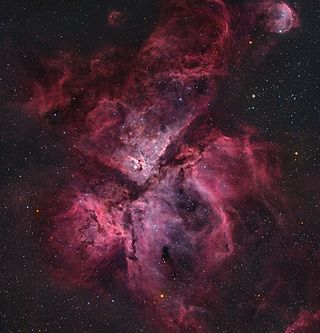
The Carina Nebula or Eta Carinae Nebula is a large, complex area of bright and dark nebulosity in the constellation Carina, located in the Carina–Sagittarius Arm of the Milky Way galaxy. The nebula is approximately 8,500 light-years (2,600 pc) from Earth.

Messier 62 or M62, also known as NGC 6266 or the Flickering Globular Cluster, is a globular cluster of stars in the south of the equatorial constellation of Ophiuchus. It was discovered in 1771 by Charles Messier, then added to his catalogue eight years later.
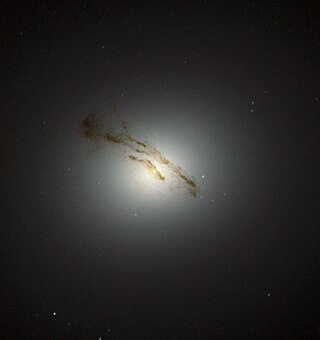
Messier 84 or M84, also known as NGC 4374, is a giant elliptical or lenticular galaxy in the constellation Virgo. Charles Messier discovered the object in 1781 in a systematic search for "nebulous objects" in the night sky. It is the 84th object in the Messier Catalogue and in the heavily populated core of the Virgo Cluster of galaxies, part of the local supercluster.

NGC 3603 is a nebula situated in the Carina–Sagittarius Arm of the Milky Way around 20,000 light-years away from the Solar System. It is a massive H II region containing a very compact open cluster HD 97950.

R136 is the central concentration of stars in the NGC 2070 star cluster, which lies at the centre of the Tarantula Nebula in the Large Magellanic Cloud. When originally named it was an unresolved stellar object but is now known to include 72 class O and Wolf–Rayet stars within 5 parsecs of the centre of the cluster. The extreme number and concentration of young massive stars in this part of the LMC qualifies it as a starburst region.
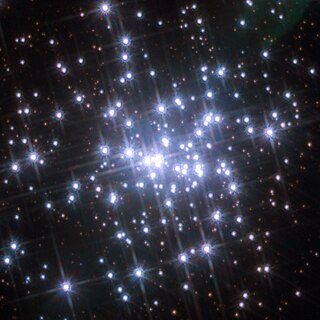
NGC 3603-A1 is a double-eclipsing binary star system located at the centre of the HD 97950 cluster in the NGC 3603 star-forming region, about 25,000 light years from Earth. Both stars are of spectral type WN6h and among the most luminous and most massive known.
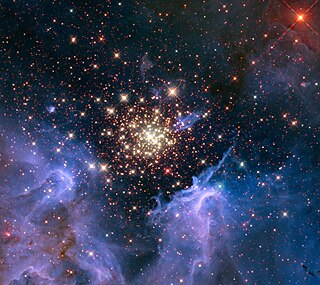
HD 97950, is the central core of a super star cluster within the NGC 3603 H II region. It was catalogued as a single star, but has now been resolved into one of the densest clusterings of stars in the galaxy.

R136a1 is one of the most massive and luminous stars known, at nearly 200 M☉ and nearly 4.7 million L☉, and is also one of the hottest, at around 46,000 K. It is a Wolf–Rayet star at the center of R136, the central concentration of stars of the large NGC 2070 open cluster in the Tarantula Nebula in the Large Magellanic Cloud. The cluster can be seen in the far southern celestial hemisphere with binoculars or a small telescope, at magnitude 7.25. R136a1 itself is 100 times fainter than the cluster and can only be resolved using speckle interferometry.

R136a2 is a Wolf-Rayet star residing near the center of the R136, the central concentration of stars of the large NGC 2070 open cluster in the Tarantula Nebula, a massive H II region in the Large Magellanic Cloud which is a nearby satellite galaxy of the Milky Way. It has one of the highest confirmed masses and luminosities of any known star, at about 151 M☉ and 3.5 million L☉ respectively.

R136c is a star located in R136, a tight knot of stars at the centre of NGC 2070, an open cluster weighing 450,000 solar masses and containing 10,000 stars. At 142 M☉ and 3.8 million L☉, it is the one of the most massive stars known and one of the most luminous, along with being one of the hottest, at over 40,000 K. It was first resolved and named by Feitzinger in 1980, along with R136a and R136b.
HD 38282 is a massive spectroscopic binary star in the Tarantula Nebula, consisting of two hydrogen-rich Wolf-Rayet stars.

NGC 3603-B is a Wolf-Rayet star located at the centre of the HD 97950 cluster in the NGC 3603 star-forming region, about 25,000 light years from Earth. It has the spectral type WN6h and is among the most luminous and most massive stars known.

NGC 3603-C is a single-lined spectroscopic binary star system located at the centre of the HD 97950 cluster in the NGC 3603 star-forming region, about 25,000 light years from Earth. The primary has spectral type WN6h and is among the most luminous and most massive known.
BAT99-98 is a Wolf–Rayet star located in the Large Magellanic Cloud, in NGC 2070 near the R136 cluster in the Tarantula Nebula. At 226 M☉ and 5,000,000 L☉ it is one of the most massive and luminous stars currently known.

NGC 152 is an open cluster in the constellation Tucana. It was discovered by John Herschel on September 20, 1835. It is located within the Small Magellanic Cloud.

NGC 411 is a globular cluster located approximately 55,000 pc (180,000 ly) from Earth in the constellation Tucana. It was discovered in 1826 by James Dunlop. It was described by Dreyer as "extremely faint, pretty large, round, gradually very little brighter middle". At a distance of about 180,000 light years (55,000 parsecs), it is located within the Small Magellanic Cloud. It has a mass of about 3.0×104 M☉, and a luminosity of about 8.0×104 L☉.
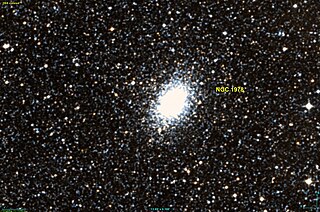
NGC 1978 is an elliptical shaped globular cluster or open cluster in the constellation Dorado. It is located within the Large Magellanic Cloud. It was discovered by James Dunlop on November 6, 1826. At an aperture of 50 arcseconds, its apparent V-band magnitude is 10.20, but at this wavelength, it has 0.16 magnitudes of interstellar extinction. It appears 3.9 arcminutes wide. NGC 1978 has a radial velocity of 293.1 ± 0.9 km/s.

ESO 444-46 is a class E4 supergiant elliptical galaxy; the dominant and brightest member of the Abell 3558 galaxy cluster around 640 million light-years away in the constellation Centaurus. It lies within the core of the massive Shapley Supercluster, one of the closest neighboring superclusters. It is one of the largest galaxies in the local universe, and possibly contains one of the most massive black holes known. The black hole's mass is very uncertain, with estimates ranging from as low as 501 million M☉, to as high as 77.6 billion M☉.
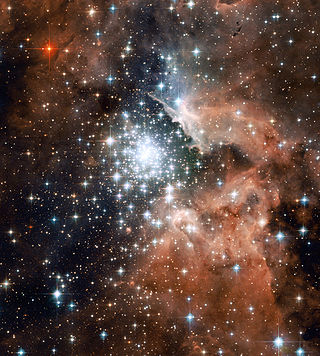
MTT 68 is a multiple star system located on the outskirts of the HD 97950 cluster in the NGC 3603 star-forming region, about 25,000 light years from Earth. It contains a rare example of an O2If* star which is one of the most luminous and most massive known.
















